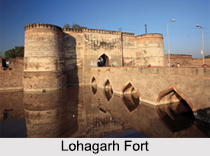 Lohagarh Fort is one of the oft-visited places of interest in Bharatpur. This fort represents the martial speciality of the Jats. There is a basic difference between this fort and the other forts of Rajasthan. There is no sign of extravagance in this fort. The massive look of the fort competes for its power.
Lohagarh Fort is one of the oft-visited places of interest in Bharatpur. This fort represents the martial speciality of the Jats. There is a basic difference between this fort and the other forts of Rajasthan. There is no sign of extravagance in this fort. The massive look of the fort competes for its power.
Location of Lohagarh Fort
Lohagarh Fort is situated at Bharatpur in Rajasthan, India. Lohagarh Fort is one of the forts in Bharatpur district, Rajasthan that was built by the Jats.
History of Lohagarh Fort
Lohagarh Fort was built in the early 18th century by Maharaja Suraj Mal, the founder of Bharatpur. According to the legends, Suraj Mal used all his power and wealth to put up different forts and palaces across his kingdom. It is one of the strongest forts ever built in India and withstood repeated assails from the British forces led by Lord Lake in 1805. Suraj Mal built the two towers within the ramparts of the fort - "Jawahar Burj" and "Fateh Burj" to celebrate his victories over the Mughals and the British.
Architecture of Lohagarh Fort
Lohagarh Fort is one of the finest architectural monuments in Rajasthan India. It was surrounded and defended by profound moats and there is a legend connected to the moats. According to the legends, the fort would fall only when a crocodile swallowed up all the water of the moats. It is believed that the gate of Lohagarh Fort Bharatpur originally belonged to the fort of Chittorgarh, but was carried away by Sultan Alauddin Khilji. The gate was brought back by the victorious Jat armies from Delhi to Bharatpur towards the end of the 17th century. Of the two gates in the fort, one in the north is known as "Ashtdhaatu" (eight metalled) gate while the one facing the south is called "Chowburja" (four-pillared) gate. One of the strongest forts in Rajasthan, Lohagarh was able to successfully thwart many a British attack.
Visiting Information of Lohagarh Fort
Bharatpur lies on the Agra to Jaipur Road, and is hence quite accessible from major destinations in Rajasthan. Bharatpur is located on the Delhi-Mumbai broad gauge railway line and also on the Delhi-Agra-Jaipur-Ahmedabad meter gauge line.



















